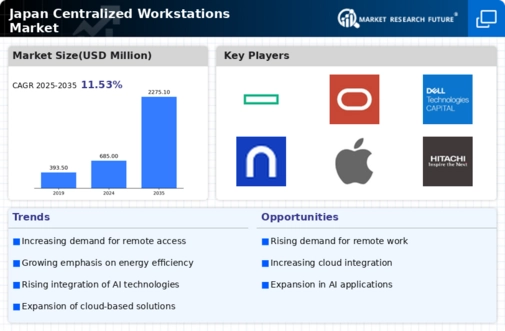Emergence of Hybrid Work Models
The emergence of hybrid work models in Japan is reshaping the centralised workstations market. As companies adopt flexible work arrangements, the need for centralized computing solutions that support both in-office and remote work is becoming increasingly apparent. Centralised workstations provide a consistent user experience, regardless of location, which is essential for maintaining productivity in a hybrid environment. This shift is likely to drive market growth, with an anticipated increase of 5% in adoption rates as organizations seek to balance flexibility with the need for robust computing resources. The ability to access centralized workstations from various locations is expected to enhance employee satisfaction and operational efficiency.
Increased Focus on Data Security
Data security remains a paramount concern for businesses in Japan, significantly impacting the centralised workstations market. As cyber threats become more sophisticated, organizations are prioritizing secure computing environments. Centralised workstations offer enhanced security features, such as centralized data management and robust access controls, which are appealing to companies looking to protect sensitive information. The market is projected to grow as businesses invest in secure infrastructure to mitigate risks associated with data breaches. According to recent studies, approximately 70% of Japanese firms are expected to increase their IT security budgets, which will likely drive demand for centralised workstations equipped with advanced security protocols.
Rising Demand for High-Performance Computing
The centralised workstations market in Japan is experiencing a notable increase in demand for high-performance computing solutions. This trend is driven by the growing need for advanced data processing capabilities across various sectors, including finance, healthcare, and engineering. As organizations seek to enhance their computational power, the market is projected to grow at a CAGR of approximately 8% over the next five years. The integration of powerful processors and enhanced graphics capabilities in centralised workstations is likely to attract businesses aiming for efficiency and productivity. Furthermore, the need for real-time data analysis and simulation in industries such as automotive and aerospace is pushing companies to invest in robust centralised workstations, thereby propelling market growth.
Shift Towards Collaborative Work Environments
In Japan, the centralised workstations market is shifting towards collaborative work environments.. Companies are increasingly adopting centralised workstations to facilitate teamwork and enhance communication among employees. This trend is particularly evident in sectors such as technology and design, where collaborative projects are essential for innovation. the centralised workstations market will benefit from this shift as organizations recognize the value of shared resources and streamlined workflows.. By providing a unified platform for collaboration, centralised workstations can improve project outcomes and reduce time-to-market. As a result, the market is likely to see a steady increase in adoption rates, with an estimated growth of 6% annually over the next few years.
Government Initiatives Supporting Digital Transformation
The Japanese government is actively promoting digital transformation across various industries, which is positively influencing the centralised workstations market. Initiatives aimed at enhancing technological infrastructure and encouraging innovation are creating a conducive environment for the adoption of centralised workstations. With government support, businesses are more inclined to invest in modern computing solutions that align with national objectives for economic growth and technological advancement. This trend is expected to result in a market growth rate of around 7% over the next few years, as organizations leverage government incentives to upgrade their IT systems and improve operational efficiency.

















Leave a Comment